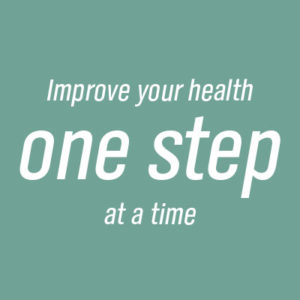News

Fruits and veggies are low in calories and full of vitamins, minerals and fiber. How important are they to your diet? The United States Department of Agriculture and ChooseMyPlate.gov recommend making them half your plate at mealtime.
If you’re having trouble getting them fresh, use frozen, canned or dried fruits and veggies. With the canned option, watch out for too much sodium or salt. Save fruit that’s too ripe for smoothies with fat-free milk or low-fat yogurt – or bake muffins or bread with it. If your family isn’t crazy about fruits and veggies, try adding them to casseroles, salads, soups and sauces, where they’ll be harder to taste.
 Looking for information to help? The Stronger Together website is a great starting place for people facing cancer. You can find all the site links, tools, apps and more to help you – from diagnosis to survivorship and everything in between.
Looking for information to help? The Stronger Together website is a great starting place for people facing cancer. You can find all the site links, tools, apps and more to help you – from diagnosis to survivorship and everything in between.
Find digital tools to:
- Make shared treatment decisions.
- Prepare for care.
- Self-manage symptoms and concerns.
- Work on a care plan.
- Learn where to go for case management help.
- Get support resources for caregivers.
 Many of us are trying to get more fruits and veggies into our diet. Want to make it easier? Try planting your own! It can be a garden in your yard, raised beds or pots on your patio. And if you don’t have room, get your neighbors involved. Community gardens are a great way to grow healthy food and bring people together. They can be set up on empty lots or in parks and schools.
Many of us are trying to get more fruits and veggies into our diet. Want to make it easier? Try planting your own! It can be a garden in your yard, raised beds or pots on your patio. And if you don’t have room, get your neighbors involved. Community gardens are a great way to grow healthy food and bring people together. They can be set up on empty lots or in parks and schools.
Another benefit to having your own garden or a shared one is being able to keep everything pesticide-free. Some flowers and herbs even act as natural pest control. So have fun, enjoy the “fruits” of your labor and plant safely.
Skin cancer is the most common form of cancer in the United States, but the good news is that it can be cured, especially when it’s found early.
If you notice any change on your skin, make an appointment with your doctor. Treatments are much more effective on cancers that are found early.
Know the warning signs
A yearly exam by a dermatologist is a key part of early detection. Signs of a problem include:*
- An open sore or bump that itches, bleeds, crusts over and then repeats for more than
- A red, irritated patch on the skin.
- A shiny bump of any color.
- A pink growth with an elevated border and a crusted indentation in the center or a growth that looks like a wart.
- A scar-like area where the skin is shiny and tight.
- Asymmetry, uneven borders, more than one color, large diameter or changes to moles – these are the signs of melanoma, the most dangerous form of skin cancer.
 Flu season starts around October and usually peaks in January/February. But you can catch the flu all year long. Symptoms may be minor, like a runny nose or sore throat, or very serious – even life-threatening. Your best protection is to get the flu vaccine each year. It’s even safe for babies as young as 6 months. Talk to your doctor if you have questions or concerns about the vaccine.
Flu season starts around October and usually peaks in January/February. But you can catch the flu all year long. Symptoms may be minor, like a runny nose or sore throat, or very serious – even life-threatening. Your best protection is to get the flu vaccine each year. It’s even safe for babies as young as 6 months. Talk to your doctor if you have questions or concerns about the vaccine.
Because the flu is spread through contact with affected people and things, good hygiene is an important defense. Wash your hands often to kill germs, and avoid people who are sick. If you get the flu, stay home for at least 24 hours after a fever passes so you’re not contagious.
 The eMagazine dedicated to improving members’ well-being
The eMagazine dedicated to improving members’ well-being
- Make time for mental health
- Mindful eating
- Exercise and feel good
- Mind-body connection
- Q: Can depression change your brain?
- Your children: The money talk
In each issue you will find information and inspiration to help you with your health and wellness goals.
 You may not see them, but dangerous germs can be unwelcome guests at mealtime. Thousands of people die in the U.S. each year because of contaminated food. Soap
You may not see them, but dangerous germs can be unwelcome guests at mealtime. Thousands of people die in the U.S. each year because of contaminated food. Soap
and water are your best defense against food-related illnesses. To keep germs from spreading, you should wash your hands throughout the day. Scrub them for 20 seconds – or about the time it takes to sing “Happy Birthday” twice. On the go, use hand sanitizer with at least a 60% alcohol base.
Clean hands are especially important when you handle food. You should make sure to clean counter tops, cutting boards, dishes and other areas where you prepare food. Never mix fresh fruits and veggies with raw meat, poultry or seafood. And don’t place cooked food back on plates that held uncooked food.
 Deciding what to put on your plate at meal time can be hard. You want to eat healthy, but you also want to feel satisfied. The good news is that you don’t have to figure out nutritional value versus calories on your own.
Deciding what to put on your plate at meal time can be hard. You want to eat healthy, but you also want to feel satisfied. The good news is that you don’t have to figure out nutritional value versus calories on your own.
Forget the old Food Pyramid. The U.S. Department of Agriculture has a new online tool called MyPlate. It can help you and your family make smarter choices in a fun, engaging way. Check out how MyPlate can make mealtime easier at myplate.gov.
 Whole grains are a very important part of a healthy, balanced diet. Barley, quinoa, wheat berries and other whole grains are full of protein, fiber, vitamins and iron your body needs. There’s also strong evidence that whole grains may lower your risk for heart disease, diabetes and high blood pressure.
Whole grains are a very important part of a healthy, balanced diet. Barley, quinoa, wheat berries and other whole grains are full of protein, fiber, vitamins and iron your body needs. There’s also strong evidence that whole grains may lower your risk for heart disease, diabetes and high blood pressure.
The biggest challenge may be knowing what a whole grain is and where to find it. To help you do just that, the Whole Grains Council created an official packaging symbol, called the Whole Grain Stamp, to identify whole grain-rich foods where you shop.
 Walking helps you stay fit and healthy. Being active even lowers your risk for serious health problems, like heart disease, stroke, Type 2 diabetes, depression and some cancers.
Walking helps you stay fit and healthy. Being active even lowers your risk for serious health problems, like heart disease, stroke, Type 2 diabetes, depression and some cancers.
Yet more than half of adults in the U.S. don’t get enough physical activity. What is enough? Adults need at least 2.5 hours – and children about an hour – of “moderately intense” aerobic activity each week for better health. This can include walking briskly, dancing, gardening and biking. A good test to see if your workout is making an impact is whether you can talk, but not sing, as you’re doing it.

